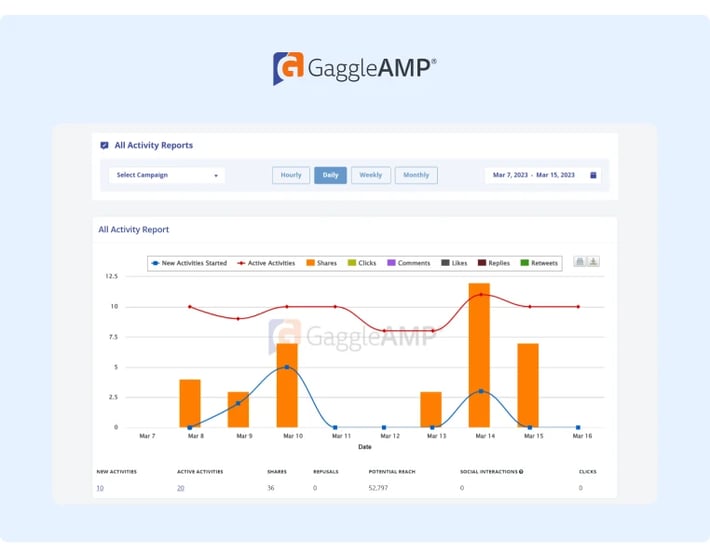How to Calculate Employee Advocacy ROI With Real Metrics
With any initiative your organization takes on, you need to have clear results.
Considering all the time, money, and energy you spent on a project, you have to know it was worth it by measuring it properly. When it comes to employee advocacy, this is no different. By measuring the right metrics, you’ll be able to show that the results you get from your employee advocacy program are worth the cost of admission and are the results you are striving for.
So, what numbers do you measure exactly? How do you measure them? And how do you show both the financial and intangible benefits your employee advocacy program produces for your brand?
Know Your Goals
Do you know the exact purpose of your employee advocacy program? Can you clearly articulate your goals?
There are many different benefits and use cases for employee advocacy. Typically, marketers and salespeople want to drive more leads and opportunities, thus additional revenue through employee advocacy on social media marketing efforts. But, what about your employee advocacy for human resources? HR may use employee advocacy to promote new job openings, specific events, or other initiatives, thereby pushing workplace culture and tapping into new resources.
Additionally, your marketing team may aim to broaden brand reach, strengthen industry connections, and boost awareness through trusted voices. One effective tactic is to blend influencer marketing with employee advocacy for expanded ROI — combining the credibility of employees with the scale of influencer-style amplification.

As an organization, all three departments are part of the same company and likely have the same broader goals of increasing brand awareness and revenue. It’s important to know your program’s goals, whether it be recruiting top talent, brand awareness, or drawing in leads, for example. Each goal changes the metrics of measurement.
When it comes to your social media marketing initiatives, you might want to boost engagement for your branded accounts, increase your employees’ social media presence, or both. There are different advantages to each, but we’ll cover how you can measure both and what numbers you should follow.
Measuring Your Social Media Marketing Metrics
In order to gauge the growth of your social media presence, you’ll want to measure these metrics:
-
Employee earned media value (EEMV): a standard that quantifies the clicks and engagement the employees in your program receive.
-
Cost per click: how much it would cost to get this level of engagement from paid ads.
-
Reach: how many people have the opportunity to see your posts.
-
Engagement: how many people reacted to your post (e.g. a ‘like’, share, or comment on the post).
-
Clicks: how many times have people clicked on a link you shared.
With employee advocacy tools like GaggleAMP, it’s very easy to measure all of these metrics.
To measure the EEMV of your program, your GaggleAMP Customer Success Manager will send you a recurring report that measures multiple areas of your employee advocacy program’s performance, including its EEMV.
The formula to measure your EEMV calculates $3 per engagement on LinkedIn and $0.50 per engagement on Twitter. This standard is a best practice to measure the monetary value of your employees’ social media presence.
The chart below shows the growth of EEMV for a small company’s program over the course of a year.

Charts just like this one are included in every GaggleAMP customer report and show the growth in value of a GaggleAMP program.
Lastly, the GaggleAMP analytics dashboard measures employee activity and engagement they accrue through the Gaggle. This includes the number of shares, clicks, likes, comments, and more.

This allows you to identify which activities on each social network got the most reach, engagement, clicks, and more, helping you get more out of your program by knowing where you get the best results. To understand the growth and improvement in your program, you’ll look at an aggregate view of how all your activities performed historically.
"GaggleAMP has the best reporting there is in employee engagement,” said Stephen Spector, former Vice President of Marketing at Buurst. “I've used several other tools and no one does it better...I've used EveryoneSocial, I've used Sprinklr, and I've used other tools. This is the best.”
Measuring Leads and Conversions
In order to see the fiscal value of your employee advocacy program, you need to see where your closed deals came from. This is easy to do with lead source tracking capabilities in GaggleAMP's employee advocacy platform.
Lead source tracking allows you to see which posts a lead clicked on to visit your site and convert to a lead. Through integrations with marketing automation tools such as Hubspot, Salesforce, Marketo, and others, tracking leads from GaggleAMP is a seamless effort. By attaching a unique tracking code to the links in your social posts, you’ll be able to tell which of your leads came from your employee advocacy program, and which of your program’s leads closed deals with you.
This allows you to take a granular look at which social posts brought leads to your website, which social network the post was on, and what activities typically garner the most leads for your organization.
Not only does this make it easy for you to show the value in your employee advocacy program, but better optimize it as well.
WGroup, (now Wavestone), used lead source tracking to measure its growth in impressions, clicks, and sales pipeline value. Over three and a half years, they generated over $2 million in sales pipeline from employee advocacy efforts.
Uncover the Hidden ROI of Your Content
Employee advocacy brings a lot of great results, but it’s important to be able to show the value of your time, effort, and money. By measuring these metrics and following these steps, you’ll be able to show quite clearly the exact monetary value of your employee advocacy program.
Measure your program through CPC savings on paid social media ads by using the CPC Calculator in the GaggleAMP platform. This simple tool tells you how much it would have cost you in paid ads to reach the same amount of engagement you achieved through your Gaggle.
It doesn’t matter how small or large your company or your Gaggle is – you can still save a lot of money on ads.













